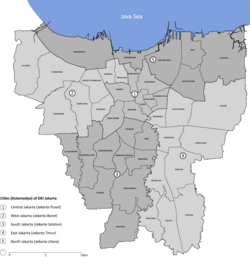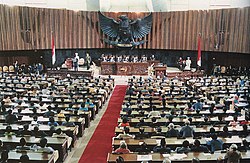| Parliamentary Complex of Indonesia | |
|---|---|
Kompleks Parlemen Republik Indonesia | |
 The main building, Nusantara | |
| General information | |
| Location | Central Jakarta, Jakarta, Indonesia |
| Coordinates | 6°12′37″S106°48′00″E / 6.21028°S 106.80000°E |
| Construction started | 8 March 1965 |
| Completed | February 1983 (Main building completed in 1968) |
| Height | 100 metres (330 ft) |
| Technical details | |
| Size | 80,000 square metres (860,000 sq ft) |
| Design and construction | |
| Architect(s) | Soejoedi Wirjoatmodjo |
The Parliamentary Complex of Indonesia (Indonesian : Kompleks Parlemen Republik Indonesia), [1] [2] also known as the MPR/DPR/DPD Building, is the seat of government for the Indonesian legislative branch of government, which consists of the People's Consultative Assembly (MPR), the House of Representatives (DPR) and the Regional Representative Council (DPD).


















